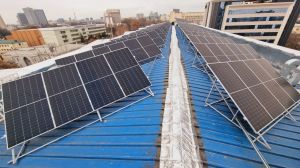
Solar’s levelized cost of electricity will reach $30/MWh in 2050, as global capacity surges, said DNV.
DNV, a global risk management firm, has offered its annual outlook on the global energy transition. It placed solar in the spotlight as the frontrunner in renewable energy supply.
“In 2050, solar PV will be in unassailable position as the cheapest source of new electricity globally,” said DNV.
As the world transitions toward carbon emissions-free electricity generation, DNV expects the share in the generation mix for coal to decrease 4% and gas to fall by 8% by mid-century. As the global fossil fuel industry becomes a metaphorical fossil itself, DNV expects the world energy mix to be 70% reliant on variable renewable sources like solar and wind power. Fossil fuels will represent just over 10% of the energy mix by that time.
Along this path, solar capacity increases 22-fold in DNV’s energy transition vision. The firm said it views variable renewables as the cheapest and quickest route to both decarbonization and energy security.
Costs are expected to improve by mid-decade. The global weighted average levelized cost of energy (LCOE) for solar is currently around $50/MWh for solar and $120/MWh for solar-plus-storage. DNV expects solar LCOE to drop to $30/MWh by mid-century, with some individual project costs well under $20/MWh.
“The main driver for this reduction in LCOE is the reduction of unit investments costs, which are around $900 per kW as a global average now,” said DNV. “This will fall significantly with every doubling of solar PV installation globally, reaching $650 per kW in 2050.”
Currently, the levelized cost of solar-plus-storage is currently more than double that of standalone solar. A continuous decline in battery prices will narrow this gap to around 50% by mid-century, said DNV.
Despite its higher costs, solar-plus-storage has an advantage in capture price. Plants with storage can charge their batteries when sunlight is plentiful during the day and sell the stored electricity when the price is high. DNV said that by 2038, the capture price advantage of solar and storage co-located projects will surpass the cost disadvantage, making these projects even more attractive.
“PV and storage systems are designed as a ‘package’ that can produce energy on demand, just like hydropower, nuclear, or combustion power plants,” said DNV.
In 10 years, DNV said roughly 20% of solar projects will be built with dedicated storage, and by mid-century such projects will reach about 50%.
“By mid-century, total installed capacity will be 9.5 TW for solar PV and 5 TW for solar and storage. The resulting 14.5 TW of solar capacity is 24 times greater than in 2020,” said DNV. “While solar will have a share of 54% of installed capacity in mid-century, it will account for 30% of global on-grid electricity generation.”
https://www.pv-magazine.com/2023/06/22/solar-to-reach-unassailable-position-as-cheapest-electricity-source-says-dnv/










